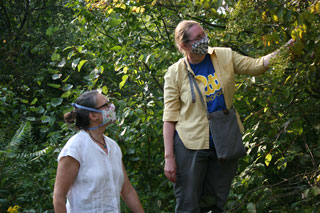Faculty study ornamental lilac to determine if invasive
Students help map spread of popular tree along campus creek

Fall can be a popular time to plant trees and bushes, but a pair of University of Pittsburgh at Bradford biology faculty members have found that there’s a popular species of lilac that may be spreading and outcompeting its native cousins.
White lilac trees (Syringa reticulata) are valued for their fluffy white early summer blooms and small root systems that keep them from pushing up sidewalks or making their way into sewer systems. Understandably, they’ve been popping up all over Bradford.
However, they’ve also been popping up along the West Bank of the Tunungwant Creek and other places they weren’t planted. Fearing that they could be an invasive species, Dr. Mary Mulcahy and Dr. Denise Piechnik designed a project for mapping the spread of the trees in the hope of learning more about how they might affect native species.
Mulcahy said she was first alerted to the phenomenon by residents who regularly walk the Richard E. McDowell Community Trail, which runs alongside the West Branch of the Tuna, and observed the white lilac trees there.
A recent article in the “Tracking Invasive Species with Pennsylvania iMapInvasives” outlined the professors’ research with students and mapped the spread of the trees along creeks in the area.
After observant citizens alerted the professors to the trees’ spread by asking about them, the professors and alumna Emily Reams ’20 spent last summer mapping the white lilacs while they bloomed, finding more than 40 of the trees along the West Branch.
The dense clumps of trees do not appear to have been planted intentionally in the creek’s flood plain, and it appears that seeds have been moved down steam and planted by the creek.
Research continued last fall with help from students, who were later able to present their findings at the Regional Science Consortium’s annual research symposium. Meaghan Adams, a pre-medicine student from Warren, and Nicholas Thompson, a biology major from Titusville, researched the natural history of the tree and the costs and benefits of its use in landscaping.
Errion Holness, a biology major from Philadelphia, and Samantha Kirchner, a double major in criminal justice and forensic science from Guys Mills, worked on testing hypotheses about the invasiveness of the tree lilac at Pitt-Bradford. Amaya Lovoz, a biology major from Silver Spring, Md., designed a study to address how popular the tree lilac is at Pennsylvania nursery, landscape and garden businesses.
In the iMapInvasives article, Mulcahy and Piechnik offered gardeners native alternatives for planting, including Juneberry, tulip poplar, ironwood and elderberry.
Mulcahy and Piechnik teach courses on biodiversity, ecology and evolution.
--30--